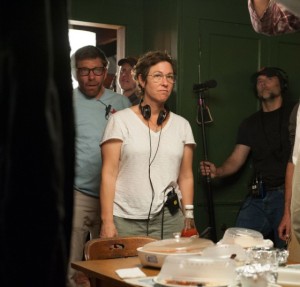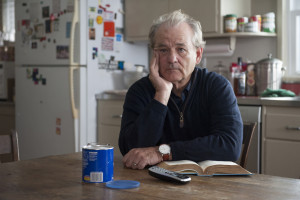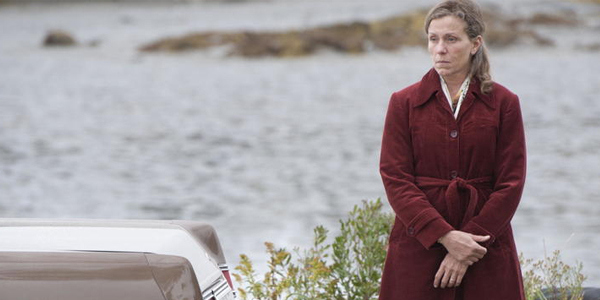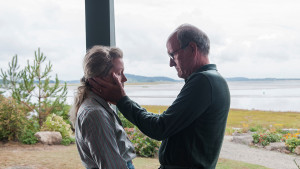Andrew Rostan was a film student before he realized that making comics was his horrible destiny, and he’s never shaken his love of cinema. Every two weeks, he’ll opine on current pictures or important movies from the past.
During the Emmys this year, a significant part of the conversation focused on both the wins of Jon Hamm and Viola Davis and the record-breaking haul for Game of Thrones. These were reasonable expectations. What surprised me and, I think, many others, were the eight awards given to another HBO program, the miniseries Olive Kitteridge. This was a show that received a great deal of advertising; but, as with CBS’s unrelenting line-up of procedurals, I didn’t know anyone who actually had watched it. Made curious by the Emmys, I fired up HBO GO and spent this past weekend viewing all four hours, and by the final shot I was a broken, sobbing heap who needed to call his parents to regain emotional equilibrium.
Olive Kitteridge joins John Adams, The Wire, and Deadwood as one of HBO’s greatest gifts to us.
A Story For Everyone
Adapted by Jane Anderson from Elizabeth Strout’s Pulitzer-winning short story collection, the miniseries is about twenty-five years in the life of Olive, a middle-school math teacher in a prosperous small town on the coast of Maine, her pharmacist husband Henry, and their neighbors. Anderson follows Strout’s lead by not including an overarching conflict or life-and-death stakes but instead finding drama in the interaction of disparate personalities. Olive is a fiercely intelligent woman who knows she has the clinical depression that runs through her family and embraces it, taking a pleasure in a brutally honest, cynical, unflinchingly realistic way of living and dealing with others. She is the sort of person who can, and will, attend her son’s wedding, make the flower girl cry, and eat mixed nuts during the ceremony. Henry, in turn, is an unfailingly gentle man who looks for the best in people and loves everyone, especially Olive, even though she unfailingly cuts him down. Their personae by turns attract and repulse others, with their son Christopher especially torn between loving and hating them.
Anderson turns this ordinariness into high art through running undertones of suicide and potential infidelity, set pieces that revolve around everyday hallmarks of existence–unexpected deaths, weddings, divorces, aging–and concise dialogue that never once sounds written. It is the definition of economic screenwriting, which makes the one moment of life-or-death melodrama in part three its only flaw. Even though the scene provokes a necessary confrontation and revelatory exchange between Henry and Olive, it feels so out-of-place with the natural flow of the rest of the production that it took several scenes to put myself back in the universe. Thankfully, Anderson recovers the realistic tone for the duration.
 Even more thankfully, Lisa Cholodenko is in the director’s chair for the first time since her outstanding The Kids Are All Right, and Olive Kitteridge is the latest and most potent ammunition for the argument that Hollywood needs more female filmmakers. Cholodenko and cinematographer Frederick Elmes make the landscapes of Maine’s oceans and forests feel intimate and living rooms, doughnut shops, and backyards feel like works of art. They shoot heartbreaking moments in scenes flooded with light, portray tenderness in spaces overcome by darkness, and mix the two together with perfect shading. The artistry combined with everyday subject matter would almost strike comparisons to Bergman and Antonioni, except Cholodenko is in her own individual class. There is a particular empathy in her framing that makes viewers care for even unlikable characters, and occasional sparks of magical realism as things Olive imagines, such as growths of wheat fields and apple peels metamorphosing into snakes, fill the screen. The closest analog may be Leave Her to Heaven, John Stahl’s 1945 film noir classic, which also uses a color-drenched Maine setting to create a heightened reality of great emotional power.
Even more thankfully, Lisa Cholodenko is in the director’s chair for the first time since her outstanding The Kids Are All Right, and Olive Kitteridge is the latest and most potent ammunition for the argument that Hollywood needs more female filmmakers. Cholodenko and cinematographer Frederick Elmes make the landscapes of Maine’s oceans and forests feel intimate and living rooms, doughnut shops, and backyards feel like works of art. They shoot heartbreaking moments in scenes flooded with light, portray tenderness in spaces overcome by darkness, and mix the two together with perfect shading. The artistry combined with everyday subject matter would almost strike comparisons to Bergman and Antonioni, except Cholodenko is in her own individual class. There is a particular empathy in her framing that makes viewers care for even unlikable characters, and occasional sparks of magical realism as things Olive imagines, such as growths of wheat fields and apple peels metamorphosing into snakes, fill the screen. The closest analog may be Leave Her to Heaven, John Stahl’s 1945 film noir classic, which also uses a color-drenched Maine setting to create a heightened reality of great emotional power.
A Master Class in Acting
Above all, Cholodenko directs her cast in a way that brings out the best in everyone. Frances McDormand and Richard Jenkins are two of America’s greatest actors; in Olive Kitteridge, they may have achieved their career peaks (I am not forgetting Fargo), inhabiting the roles of Olive and Henry. McDormand mostly comes across as a volcano undergoing a slow but steady eruption, her face and body rigid, controlled, and indomitable while her voice, rolling with sarcasm, impatience, and anger, conveys emotion through subtle shifts of inflection. She doesn’t seem to be acting at all, and it makes the occasional moments when her steeliness cracks to reveal the love and pain under the surface all the more telling. Jenkins wears every emotion on his sleeve and fights to keep the smile on his face as much as McDormand fights to keep her bitterness intact, but is always the first to crash into sorrow and sadness. In many ways he becomes the audience analogue; Henry’s unfailing tenderness to Olive and faithfulness in the face of temptation keeps the audience on her side, and when Henry’s world is irrevocably shaken, the crash is palpably felt.
 The supporting cast around McDormand and Jenkins is excellent. Broadway star John Gallagher, Jr. is great as Christopher, depicting his revolving love and hate for Olive and Henry perfectly, and equally good are Zoe Kazan (masterfully playing against type as a character nicknamed “the mouse” who inspires passion in Henry), Peter Mullan (the drinking English teacher who tempts Olive), and Audrey Marie Anderson (Olive’s exasperating but oddly adoring daughter-in-law). Then there is Bill Murray, whom Cholodenko works with as well as Sofia Coppola and Wes Anderson did in the past. Imposing even when lying down, filled with equal parts melancholy and dry wit, Murray appears for only about twenty minutes in a part whose specifics would spoil the plot, but he captures the imagination.
The supporting cast around McDormand and Jenkins is excellent. Broadway star John Gallagher, Jr. is great as Christopher, depicting his revolving love and hate for Olive and Henry perfectly, and equally good are Zoe Kazan (masterfully playing against type as a character nicknamed “the mouse” who inspires passion in Henry), Peter Mullan (the drinking English teacher who tempts Olive), and Audrey Marie Anderson (Olive’s exasperating but oddly adoring daughter-in-law). Then there is Bill Murray, whom Cholodenko works with as well as Sofia Coppola and Wes Anderson did in the past. Imposing even when lying down, filled with equal parts melancholy and dry wit, Murray appears for only about twenty minutes in a part whose specifics would spoil the plot, but he captures the imagination.
Olive Kitteridge, as mentioned above, is currently on HBO streaming services as well as DVD, and it is worth the four hours of your time. I almost guarantee some part of this tale will relate to your life and provoke self-examination and a phone call to family and friends. It is art the way art should be made, and a film I want to rewatch every decade or so as I age.
Photographs from HBO, Indiewire, Collider, and California College of the Arts.





